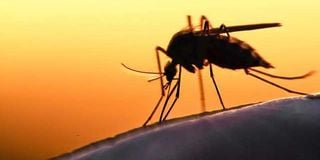Premium
Malaria spreads to new areas due to climate change

The new mosquito species, scientifically identified as Anopheles stephensi, has been reported in many African countries including Nigeria, Ethiopia, Somalia, Sudan and Djibouti.
The reality of climate change is slowly sinking in, and its impact is spreading to disease.
A new study published in the scientific journal Biology Letters shows that the tiny mosquitoes, which transmit malaria, may now and in the future thrive in areas where they never existed before.
The researchers, who scraped through data from 1898 to 2016, observed that the anopheles mosquito in sub-Saharan Africa has moved away from the equator, going higher up by about 4.7 kilometres every year.
“If climate change has allowed anopheles mosquitoes to invade once-protected colder areas, this might help explain observed changes in the altitudinal limits of malaria transmission, without presuming the veracity of a climate-driven, long-term increase in prevalence in these areas,” said the researchers.
The study confirms that warmer temperatures caused by climate change have allowed mosquitoes to thrive in the highlands of East Africa.
“We found clear evidence that anopheles mosquitoes have undergone rapid range shifts over the twentieth century, challenging a long-standing assumption in historical epidemiology that mosquito ranges are mostly stationary over decades or centuries,” they explained.
This comes a few weeks after Kenyan researchers published a study in the Research Square journal highlighting that a new malaria vector called Anopheles stephensi had been spotted in the northern part of Kenya. One of their explanations for the emergence of the new vector was climate change.
“With rapid, often unplanned urbanisation in Africa, many of the urban centres have poor refuse disposal and drainage systems which are potential larval habitats of Anopheles stephensi. Coupled with climate change, which creates suitable climatic conditions for mosquito breeding, there is great potential for the spread and establishment of Anopheles stephensi in African cities,” said the Kenyan scientists.
Dr Ednah Ototo, a parasitologist who has researched climate change and malaria, told the Nation that climate variability is already affecting mosquito breeding in the country.
Explaining the shift to highland areas, Dr Ototo said that with the variability, even the highland zones are becoming warmer.
“We have observed that even during wet periods, the temperatures are now higher than usual. A combination of wetness plus high temperatures is a good breeding ground for mosquitoes,” she explained. “Anywhere there is water, and warmth, a mosquito will likely thrive. If the water is too cold, the mosquitoes’ eggs may not hatch. This is why previously, mosquitoes were not likely to be in the highlands.”
Despite the changes already happening, Dr Ototo said climate-friendly human activities can help to reverse some of the negative impacts.
“The basic act of planting trees goes a long way. Anywhere that there are trees has its own micro-climate,” she explained.
Dr Ototo added that existing interventions to keep malaria at bay should be expanded to non-endemic regions. This, she said, includes individual actions such as draining stagnant.





